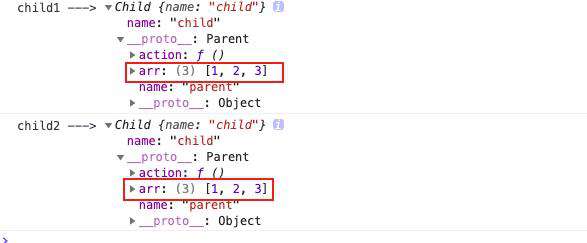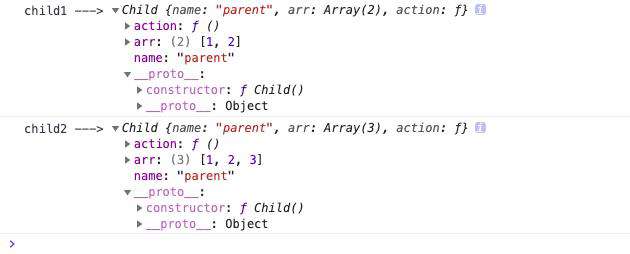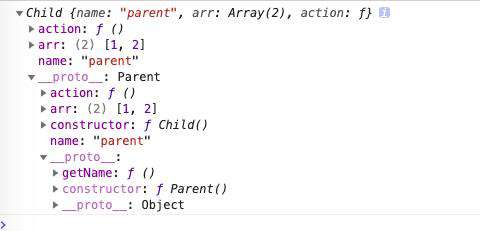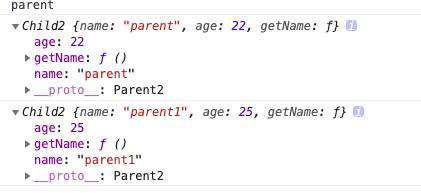1. 原型继承
原型继承是比较常见一种继承方式
function Parent() {
this.name = 'parent'
this.action = function () {
console.log(this.name)
return this.name
},
this.arr = [1,2]
}
Parent.prototype.getName = function () {
console.log(this.name)
return this.name
}
function Child() {
this.name = 'child'
}
// 实例化父函数,链接到自己的原型链上
Child.prototype = new Parent
const child1 = new Child
console.log(child1)

从上图中可以看到, 原型继承的特点:把父类的公有(prototype)+私有属性都继承到了子类的原型上(公有属性 prototype)
注意:原型继承的缺点
const child2 = new Child
console.log(child1)
child2.arr.push(3)
如果有一个子类 child2 调用 父类的 arr 属性并添加了内容
此时来看 child1 和 child2
 从上面的结果中发现,child2 修改了父类的属性,child1 的父类属性也被修改了。这也很好理解,因为它俩都继承与同一个 parent。它们的内存空间是共享的。
所以:
从上面的结果中发现,child2 修改了父类的属性,child1 的父类属性也被修改了。这也很好理解,因为它俩都继承与同一个 parent。它们的内存空间是共享的。
所以:原型的缺点:子类会共享父类的的内存空间
构造函数继承(借用 call 或 apply)
function Parent() {
this.name = 'parent'
this.action = function () {
console.log(this.name)
return this.name
},
this.arr = [1,2]
}
Parent.prototype.getName = function () {
console.log(this.name)
return this.name
}
 使用这种解决了数据共享的问题
使用这种解决了数据共享的问题
但是: 只能继承父类的实例属性和方法,不能继承原型属性或者方法。
组合继承 (call + prototype)
function Parent() {
this.name = 'parent'
this.action = function () {
console.log(this.name)
return this.name
},
this.arr = [1,2]
}
Parent.prototype.getName = function () {
console.log(this.name)
return this.name
}
function Child() {
this.name = 'child'
Parent.call(this)
}
Child.prototype = new Parent
Child.prototype.constructor = Child
const child1 = new Child
console.log(child1)

优点:解决了 原型继承和构造函数继承的缺点。
但是这种方式也有缺陷:从上图中可以看出,子类原型上多了一份父类的实例属性。因为父类的构造函数被调用了两次,生成了两份,子类实例上的屏蔽了原型上的,造成了内存浪费
寄生式继承 (Object.create)
就是使用原型继承获取一份浅拷贝对象。然后利用这个浅拷贝对象在进行增强。 缺点和原型继承一样,但对于普通对象的继承来说,可以在父类的基础上添加更多的方法
let Parent1 = {
arr: ['a', 'b'],
name: 'Parent1',
getName: function() {
return this.name
}
}
function Child(parent) {
let copy = Object.create(parent)
console.log(copy)
copy.getArray = function () {
return this.arr
}
return copy
}
let Child1 = Child(Parent1)
console.log(Child(Parent1))
console.log('child1 -->', Child1.getArray()) // ['a', 'b']
console.log('child1 -->', Child1.getName()) // Parent1
- 缺点 不能实例化,也没有用到原型。
寄生组合式继承
function Parent() {
this.name = 'parent'
this.action = function () {
return this.name
},
this.arr = [1,2]
}
Parent.prototype.getName = function () {
return this.name
}
function Child() {
Parent.call(this)
}
Child.prototype = Object.create(Parent.prototype)
Child.prototype.constructor = Child
const child1 = new Child
const child2 = new Child
console.log(child1)
- 解决了上面几种几种的缺陷,也较好的实现了继承的结果即
父类私有属性放放子类私有中,原型上的属性和方法放到子类原型上
注意:上面写的继承中,为什么要手动修改 constructor 的指向
因为:在 JS 的规定中,xxx.prototype.constructor 的指向是当前函数(类)本身。也就是指向自己,我们上面用到的寄生继承、组合继承等,如果不修改 constructor 的指向,它会指向 Parent 这个类, 如下:
// Child.prototype.constructor = Child
console.log('constructor -->', Child.prototype.constructor === Parent) // true
去掉手动指向,Child 的 constructor 就指向了 Parent,所以违背了 JS 的标准规范。
ES6 extends 关键字
在 ES6 中,直接使用 extends 关键字可以很容易的实现 JavaScript 继承,并且 babel 编辑之后,它采用的也是 寄生组合继承的方式,这种方式是较优的解决继承的方式。
class Parent2 {
constructor(name) {
this.name = name
}
getName = function (){
return this.name
}
}
class Child2 extends Parent2 {
constructor(name, age) {
super(name)
this.age = age
}
}
const child3 = new Child2('parent', 22)
const child4 = new Child2('parent1', 25)
console.log(child3.getName())
console.log(child3)
console.log(child4)

常见问题FAQ
- 免费下载或者VIP会员专享资源能否直接商用?
- 本站所有资源版权均属于原作者所有,这里所提供资源均只能用于参考学习用,请勿直接商用。若由于商用引起版权纠纷,一切责任均由使用者承担。更多说明请参考 VIP介绍。
- 提示下载完但解压或打开不了?
- 找不到素材资源介绍文章里的示例图片?
- 模板不会安装或需要功能定制以及二次开发?




发表评论
还没有评论,快来抢沙发吧!